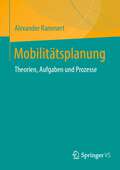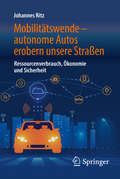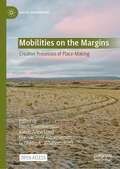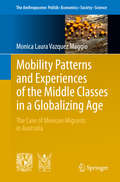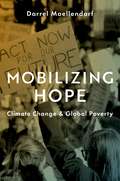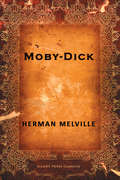- Table View
- List View
Mobilität und berufliche Lebensereignisse: Eine Mixed-Method-Studie zu Verkehrsmittelnutzung unter Einfluss von Identitätsänderungen und einer Soft-Policy-Intervention (Studien zur Mobilitäts- und Verkehrsforschung)
by Julia SchuppanJulia Schuppan untersucht die Wirksamkeit betrieblichen Mobilitätsmanagements in beruflichen Lebensereignissen. In einem zwischen Soziologie, Psychologie und Geografie verorteten Ansatz werden berufliche Lebensereignisse als geeignete Gelegenheitsfenster für Mobilitätsmanagement identifiziert und als komplexe Übergänge im Kontext zwischen individuellem Erleben, Sozialisationseinflüssen und Identitätsänderungen skizziert. In einer Mixed-Method-Studie zeigt die Autorin, dass berufliche Lebensereignisse dann ein Gelegenheitsfenster für Mobilitätsänderung sein können, wenn Mobilität identitätsstiftende und für den Übergang unterstützende Funktionen erfüllt. Betriebliches Mobilitätsmanagement kann nur dann effektiv sein, wenn es Identitätsaspekte aufgreift und als institutionelle Unterstützungsleistung im beruflichen Übergang wirkt.
Mobilitätsplanung: Theorien, Aufgaben und Prozesse
by Alexander RammertDieses Buch umfasst die wesentlichen Grundlagen einer praxisorientierten Mobilitätsplanung. Im Gegensatz zur Verkehrsplanung fokussiert sich die Mobilitätsplanung auf den Menschen als zentrale Figur der Verkehrsentwicklung und entwirft daraus neue Perspektiven für die Planung. Mobilitätsplanung löst damit die Abhängigkeit vom technischen Artefakt des Verkehrs und zielt stattdessen darauf ab, direkt die Möglichkeiten der Menschen zu verstehen und zu beeinflussen. Das Buch richtet sich somit an alle Akteure, welche die Mobilität der Menschen in unterschiedlicher Weise beeinflussen. Klassischerweise gehören hierzu alle Ebenen der Planungspraxis, von Ministerien bis hin zu kommunalen Verwaltungen und Planungsbüros. Aber auch politisch Entscheidungstragende, Unternehmen und zivilgesellschaftliche Akteure gehören zu den Adressaten dieses Buches, da sie maßgeblich an der zukünftigen Entwicklung von Mobilität und Verkehr mitwirken.
Mobilitätswende – autonome Autos erobern unsere Straßen: Ressourcenverbrauch, Ökonomie und Sicherheit
by Johannes RitzDieses Buch beleuchtet die unterschiedlichen Facetten einer Mobilität mit selbstfahrenden (autonomen) Fahrzeugen. Angefangen bei der Elektromobilität, werden die Parkplatzproblematik, Carsharing und Haftungsfragen unter dem Aspekt einer zunehmenden Verbreitung autonomer Fahrzeuge betrachtet. Auch ökonomische und umweltpolitische Fragen sind aufgeworfen (Ressourcenknappheit, Klimawandel, automatisierte Logistik) und versucht zu beantworten. Können Maschinen moralisch handeln, wie steht es um die Cybersicherheit und den Technikmissbrauch, sind weitere Fragen, die in diesem Buch thematisiert werden.
Mobilities on the Margins: Creative Processes of Place-Making (Arctic Encounters)
by Björn Thorsteinsson Katrín Anna Lund Gunnar Thór Jóhannesson Guðbjörg R. JóhannesdóttirThis open access book examines places on the margins and the dynamics through which a marginal position of a place is created. Specifically, it explores how places, mostly in sparsely populated areas, often perceived as immobile and frozen in time, come into being and develop through interference of everyday mobilities and creative practices that cut across the spheres of culture and nature as usually defined. Through fieldwork and case studies from areas in Iceland, Finland, Greenland, and Scotland, the book’s twelve chapters draw out the multiple relations through which places emerge, where people compose their lives as best they can with their surroundings. A special concern is to explore the links between travelling, landscape, and material culture and how places and margins are enacted through mobilities and creative practices of humans and other beings. The emphasis on mobility disturbs the perception of a place as a bounded entity and offers a useful and necessary understanding of places as mobile and fluid. Mobilities on the Margins is a novel and timely contribution to the exploration of human and more-than-human interactions in a world of increasingly fluid mobilities and insistent crises.
Mobility and Migration in Indigenous Amazonia: Contemporary Ethnoecological Perspectives (Environmental Anthropology and Ethnobiology #11)
by Miguel N. AlexiadesContrary to ingrained academic and public assumptions, wherein indigenous lowland South American societies are viewed as the product of historical emplacement and spatial stasis, there is widespread evidence to suggest that migration and displacement have been the norm, and not the exception. This original and thought-provoking collection of case studies examines some of the ways in which migration, and the concomitant processes of ecological and social change, have shaped and continue to shape human-environment relations in Amazonia. Drawing on a wide range of historical time frames (from pre-conquest times to the present) and ethnographic contexts, different chapters examine the complex and important links between migration and the classification, management, and domestication of plants and landscapes, as well as the incorporation and transformation of environmental knowledge, practices, ideologies and identities.
Mobility Patterns and Experiences of the Middle Classes in a Globalizing Age: The Case of Mexican Migrants in Australia (The Anthropocene: Politik—Economics—Society—Science #6)
by Monica Laura Vazquez MaggioThe book presents insights from a mixed methodology study that examines recent mobility patterns exhibited by the middle classes. Its major contributions are two-fold: theoretically, it advances the conceptualisation of middle class migration; empirically, it analyses the migratory motivations of a relatively new Latin-American group in Australia. The accelerated insertion of the Mexican society into globalisation processes is strongly linked not only to the growing participation in migration phenomena but also to people’s outflow to new destinations. Although studies of Mexican emigration are vast, research on Mexican skilled migration is scarce, and research that focuses on mobility to non-USA destinations is even scarcer. Mexicans are a relatively new addition to Australia’s multicultural society, and little is known about this group’s profile and why they choose to migrate to Australia. Employing a mixed methodology approach, the book provides a comprehensive portrait of migration in a new group.
Mobilizing Hope: Climate Change and Global Poverty
by Darrel MoellendorfThe global climate crisis and other pressures on planetary ecology cause profound anxieties for humanity. Climate change threatens to trap hundreds of millions of people in dire poverty-widening the gap in an already deeply divided economy. However, a new generation of activists is offering inspiration, raising hopes in a seemingly hopeless situation. In Mobilizing Hope: Climate Change and Global Poverty, Darrel Moellendorf discusses climate change, global poverty, justice, and the importance of political responses, both internationally and domestically, that offer hope. While there are reasons to worry that the era of pervasive human planetary impact, the Anthropocene, could produce terrible global injustices and massive environmental destruction, that need not be so. Moellendorf contends that the work of bringing about a world united in creating sustainable solutions to environmental crises, that values the Earth's natural wonders, and actualizes a vision of economic justice, is the work of mobilizing hope.
Mobilizing Hope: Climate Change and Global Poverty
by Darrel MoellendorfThe global climate crisis and other pressures on planetary ecology cause profound anxieties for humanity. Climate change threatens to trap hundreds of millions of people in dire poverty-widening the gap in an already deeply divided economy. However, a new generation of activists is offering inspiration, raising hopes in a seemingly hopeless situation. In Mobilizing Hope: Climate Change and Global Poverty, Darrel Moellendorf discusses climate change, global poverty, justice, and the importance of political responses, both internationally and domestically, that offer hope. While there are reasons to worry that the era of pervasive human planetary impact, the Anthropocene, could produce terrible global injustices and massive environmental destruction, that need not be so. Moellendorf contends that the work of bringing about a world united in creating sustainable solutions to environmental crises, that values the Earth's natural wonders, and actualizes a vision of economic justice, is the work of mobilizing hope.
Moby-Dick
by Henry MelvilleMoby-Dick; or, The Whale is a novel by American writer Herman Melville, published in 1851 during the period of the American Renaissance. Sailor Ishmael tells the story of the obsessive quest of Ahab, captain of the whaler Pequod, for revenge on Moby Dick, the white whale that on the previous whaling voyage bit off Ahab's leg at the knee. The novel was a commercial failure but during the 20th century, its reputation as a Great American Novel was established. The product of a year and a half of writing, the book draws on Melville's experience at sea, on his reading in whaling literature, and on literary inspirations such as Shakespeare and the Bible. The white whale is modeled on the notoriously hard to catch actual albino whale Mocha Dick, and the ending is based on the sinking of the whaler Essex by a whale. The detailed and realistic descriptions of whale hunting and of extracting whale oil, as well as life aboard ship among a culturally diverse crew, are mixed with exploration of class and social status, good and evil, and the existence of God. In addition to narrative prose, Melville uses styles and literary devices ranging from songs, poetry, and catalogs to Shakespearean stage directions, soliloquies, and asides.
Moby-Dick: Ahab, Captain Of The Whaling Ship For Revenge The White Whale (Macmillan Collector's Library #62)
by Herman MelvilleDesigned to appeal to the booklover, the Macmillan Collector's Library is a series of beautiful gift editions of much loved classic titles. Macmillan Collector's Library are books to love and treasure.This beautiful Macmillan Collector's Library edition of Moby-Dick features an afterword by Nigel Cliff.On board the whaling ship Pequod a crew of wise men and fools, renegades and seeming phantoms is hurled through treacherous seas by crazed Captain Ahab, a man hell-bent on hunting down the mythic White Whale. Herman Melville transforms the little world of the whale ship into a crucible where mankind's fears, faith and frailties are pitted against a relentless fate. Teeming with ideas and imagery, and with its extraordinary intensity sustained by mischievous irony and moments of exquisite beauty, Moby-Dick is both a great American epic and a profoundly imaginative literary creation.
The Model Arab League manual: A guide to preparation and performance
by Philip A. D’Agati Holly JordanThis textbook provides a comprehensive overview of the Model Arab League (MAL) programme for first time and returning students. Drawing on over fourteen years of combined experience in successfully leading award-winning MAL delegations, Philip D’Agati and Holly A. Jordan provide students with an introduction to being a delegate and tips on effective research techniques as well as simplifying the complex process of taking on the identity of a state and then representing it effectively in a MAL debate.
Model Tests and Numerical Simulations of Liquefaction and Lateral Spreading: LEAP-UCD-2017
by Bruce L. Kutter Majid T. Manzari Mourad ZeghalThis open access book presents work collected through the Liquefaction Experiments and Analysis Projects (LEAP) in 2017. It addresses the repeatability, variability, and sensitivity of lateral spreading observed in twenty-four centrifuge model tests on mildly sloping liquefiable sand. The centrifuge tests were conducted at nine different centrifuge facilities around the world. For the first time, a sufficient number of experiments were conducted to enable assessment of variability of centrifuge test results. The experimental data provided a unique basis for assessing the capabilities of twelve different simulation platforms for numerical simulation of soil liquefaction. The results of the experiments and the numerical simulations are presented and discussed in papers submitted by the project participants. The work presented in this book was followed by LEAP-Asia that included assessment of a generalized scaling law and culminated in a workshop in Osaka, Japan in March 2019. LEAP-2020, ongoing at the time of printing, is addressing the validation of soil-structure interaction analyses of retaining walls involving a liquefiable soil. A workshop is planned at RPI, USA in 2020.
Modeling Demographic Processes in Marked Populations (Environmental and Ecological Statistics #3)
by Michael J. Conroy Evan G. Cooch David L ThomsonHere, biologists and statisticians come together in an interdisciplinary synthesis with the aim of developing new methods to overcome the most significant challenges and constraints faced by quantitative biologists seeking to model demographic rates.
Modeling for Sustainable Management in Agriculture, Food and the Environment
by George VlontzosRecent developments in computer science, data mining and big data analytics have resulted in new operational frameworks in agriculture, food and the environment, which in fact, share a strong link between them. A key challenge for researchers is to extract new data patterns and utilize them in decision making. Managers, policy makers, and practitioners have to be aware of these methodologies in order to establish efficient and effective working groups for the tasks to be resolved. The book reviews the complexity of the interrelationship between agriculture, food production and processing, and environmental issues. It also highlights the prospects of modeling in various cases of problem solving in these sectors, and reviews the new and future challenges. Consumer awareness in food production and processing practices is continually increasing and the necessity for advanced behavioural tools follows the same trend. Furthermore, the value chain management challenge is becoming one of the most crucial tasks due to the increased importance of new parameters like the origin of products, its environmental footprint and the enhancement of local production, etc. The book addresses these topics in a holistic approach, merging modeling with advanced marketing practices in a coherent and innovative manner, being an effective tool in a continuously demanding world.
Modeling for Sustainable Management in Agriculture, Food and the Environment
by George Vlontzos Yiannis Ampatzidis Basil Manos Panos M. PardalosRecent developments in computer science, data mining and big data analytics have resulted in new operational frameworks in agriculture, food and the environment, which in fact, share a strong link between them. A key challenge for researchers is to extract new data patterns and utilize them in decision making. Managers, policy makers, and practitioners have to be aware of these methodologies in order to establish efficient and effective working groups for the tasks to be resolved. The book reviews the complexity of the interrelationship between agriculture, food production and processing, and environmental issues. It also highlights the prospects of modeling in various cases of problem solving in these sectors, and reviews the new and future challenges. Consumer awareness in food production and processing practices is continually increasing and the necessity for advanced behavioural tools follows the same trend. Furthermore, the value chain management challenge is becoming one of the most crucial tasks due to the increased importance of new parameters like the origin of products, its environmental footprint and the enhancement of local production, etc. The book addresses these topics in a holistic approach, merging modeling with advanced marketing practices in a coherent and innovative manner, being an effective tool in a continuously demanding world.
Modeling Forest Trees and Stands
by Harold E. Burkhart Margarida ToméDrawing upon a wealth of past research and results, this book provides a comprehensive summary of state-of-the-art methods for empirical modeling of forest trees and stands. It opens by describing methods for quantifying individual trees, progresses to a thorough coverage of whole-stand, size-class and individual-tree approaches for modeling forest stand dynamics, growth and yield, moves on to methods for incorporating response to silvicultural treatments and wood quality characteristics in forest growth and yield models, and concludes with a discussion on evaluating and implementing growth and yield models. Ideal for use in graduate-level forestry courses, this book also provides ready access to a plethora of reference material for researchers working in growth and yield modeling.
Modeling of Land-Use and Ecological Dynamics (Cities and Nature)
by Dan Malkinson, Danny Czamanski and Itzhak BenensonAs cities are rapidly expanding and encroaching into agricultural and natural areas, a question of primary concern is how this expansion affects surrounding agriculture and natural landscapes. This book presents a wide spectrum of both theoretical and empirical approaches to simulation and assessment of landscape dynamics. The first part presents state-of-the-art modelling approaches pertaining to land-use changes entailed by the urban sprawl, at different spatial resolutions and temporal time scales. The second part is dedicated to case studies of the effects and consequences of the emerging urban-agriculture open space patterns.
Modelling Complex Ecological Dynamics: An Introduction into Ecological Modelling for Students, Teachers & Scientists
by Melanie TrexlerModel development is of vital importance for understanding and management of ecological processes. Identifying the complex relationships between ecological patterns and processes is a crucial task. Ecological modelling—both qualitatively and quantitatively—plays a vital role in analysing ecological phenomena and for ecological theory. This textbook provides a unique overview of modelling approaches. Representing the state-of-the-art in modern ecology, it shows how to construct and work with various different model types. It introduces the background of each approach and its application in ecology. Differential equations, matrix approaches, individual-based models and many other relevant modelling techniques are explained and demonstrated with their use. The authors provide links to software tools and course materials. With chapters written by leading specialists, “Modelling Complex Ecological Dynamics” is an essential contribution to expand the qualification of students, teachers and scientists alike.
Modelling Long-term Scenarios for Low Carbon Societies
by Neil Strachan Tim Foxon Junichi FujinoWith the ever-increasing impacts of climate change, it is now clear that global society will have to restructure its energy systems in order to decrease carbon emissions. The scenarios under which this transition to low-carbon societies (LCS) could occur would have complex economic, technological, behavioural and policy implications. This volume, a supplement to the Climate Policy journal, considers these implications by examining different low-carbon scenarios for different countries, modelled at different scales and typologies. Two overview chapters, co-written by international experts, set the context of scenario development and quantification of LCS, and summarize the findings on the economic implications, societal responses, technological developments and required policy measures to enable LCS across a range of countries. Further chapters detail the modelling of various scenarios and outline the model methodology, detail the economic and technological consequences of transitions to LCS, and comment on the strengths and weaknesses of specific policies.
Modelling Long-term Scenarios for Low Carbon Societies
by Neil Strachan Tim Foxon Junichi FujinoWith the ever-increasing impacts of climate change, it is now clear that global society will have to restructure its energy systems in order to decrease carbon emissions. The scenarios under which this transition to low-carbon societies (LCS) could occur would have complex economic, technological, behavioural and policy implications. This volume, a supplement to the Climate Policy journal, considers these implications by examining different low-carbon scenarios for different countries, modelled at different scales and typologies. Two overview chapters, co-written by international experts, set the context of scenario development and quantification of LCS, and summarize the findings on the economic implications, societal responses, technological developments and required policy measures to enable LCS across a range of countries. Further chapters detail the modelling of various scenarios and outline the model methodology, detail the economic and technological consequences of transitions to LCS, and comment on the strengths and weaknesses of specific policies.
Modelling Oceanic Climate Interactions (Nato ASI Subseries I: #11)
by Jürgen Willebrand David L. T. AndersonThe ocean plays a central role in determining the climate of the earth. The oceanic circulation largely controls the temporal evolution of cli mate changes resulting from human activities such as the increase of greenhouse gases in the atmosphere, and also affects the magnitude and regional distribution of those changes. On interannual and longer time scales the ocean is, through its interaction with the atmosphere, a source of important natural climate variations which we are only now beginning to recognise but whose cause has yet to be properly determined. Chem ical and biological processes in the ocean are linked to climate change, particularly through interaction with the global carbon cycle. A quantitative understanding of the oceanic role in the climate system requires models which include many complex processes and interactions, and which are systematically verified with observations. This is the ob jective of global research programs such as TOGA, WOCE, and JGOFS. Coupled numerical models of the oceanic and atmospheric circulation constitute the basis of every climate simulation. Increasingly it is recog nized that in addition a biological/chemical component is necessary to capture the pathways of carbon and other trace gases. The development of such coupled models is a challenging task which needs scientists who must be cognizant of several other disciplines beyond their own specialty.
Modelling of Environmental Chemical Exposure and Risk (NATO Science Series: IV: #2)
by Jan B. H. J. LindersMathematical models are being increasingly used to estimate the concentrations of a wide range of substances in the environment for a variety of reasons, including government control and legislation, and risk and hazard estimation. Exposure assessment has to be performed for many types of substances, including pesticides, industrial chemicals, pollutants, accidental discharges, etc. The interpretation of the results of model equations should always bear in mind the purpose for which the model used was built in the first place. Further, models are always an abstraction of reality, requiring simplifying assumptions to keep the models within the restraints posed by computer performance and/or scientific knowledge. The present book treats the theme of modelling chemical exposure and risk in terms of four main topics: model characteristics, applications, comparison of estimated with measured concentrations, and modelling credibility.
Modelling of Hydrological Processes in the Narew Catchment (GeoPlanet: Earth and Planetary Sciences)
by Dorota Świątek and Tomasz OkruszkoSince climate and land use strongly affect the runoff pattern and intensity of solute export, it is likely that some observations and conclusions formulated on the basis of investigations carried out in forested catchment may not be fully adequate to describe controls on solute export from agricultural watersheds. The primary objective of the present research is to better understand the flow paths that affect the fluxes of dissolved compounds from a small agricultural catchment during snowmelt. This book focuses on spring snowmelt, because this is the dominant hydrological event in many moderate and high latitude catchments and, thus, is regarded as a prominent factor influencing the quality of surface waters
Modelling of Soil Behaviour with Hypoplasticity: Another Approach to Soil Constitutive Modelling (Springer Series in Geomechanics and Geoengineering)
by David MašínThis book explains the hypoplastic modelling framework. It is divided into two parts, the first of which is devoted to principles of hypoplasticity. First, the basic features of soil’s mechanical behaviour are introduced, namely non-linearity and asymptotic properties. These features are then incorporated into simple one-dimensional hypoplastic equations for compression and shear. Subsequently, a hypoplastic equivalent of the Modified Cam-Clay model is developed in 2D space using stress and strain invariants to demonstrate key similarities and differences between elasto-plastic and hypoplastic formulations. Lastly, the mathematical structure of hypoplastic models is explained by tracing their historical development, from the early trial-and-error models to more recent approaches. In turn, Part II introduces specific hypoplastic models for soils. First, two reference models for sand and clay are defined. After summarising their mathematical formulations, calibration procedures are described and discussed. Subsequently, more advanced modelling approaches are covered: the intergranular strain concept incorporating the effects of small strain stiffness and cyclic loading, viscohypoplasticity for predicting rate effects, soil structure to represent structured and bonded materials and soil anisotropy. The book concludes with a description of partial saturation and thermal effects: topics that are increasingly important to the disciplines of energy and environmental geotechnics. Selecting a constitutive model and its parameters is often the most important and yet challenging part of any numerical analysis in geotechnical engineering. Hypoplasticity involves a specific class of soil constitutive models, which are described in detail here. The book offers an essential resource, both for model users who need a more advanced model for their geotechnical calculations and are mainly interested in parameter calibration procedures, and for model developers who are seeking a comprehensive understanding of the mathematical structure of hypoplasticity.
Modelling Potential Malaria Spread in Germany by Use of Climate Change Projections: A Risk Assessment Approach Coupling Epidemiologic and Geostatistical Measures (SpringerBriefs in Environmental Science)
by Winfried Schröder Gunther SchmidtThis book investigates the spatial distribution of potential temperature-driven malaria transmissions, using the basic reproduction rate (R0) to model the reproduction of the malaria pathogen Plasmodium vivax. The authors mapped areas at risk of an outbreak of tertian malaria in the federal state of Lower Saxony (pre-study) and for whole Germany (main-study) by means of geostatistics for past (1947-2007) and future periods. Projections based on predicted monthly mean air temperature data derived from the IPCC and regionally discriminated by two regional climate models (REMO, WettReg) for the countrywide study.

